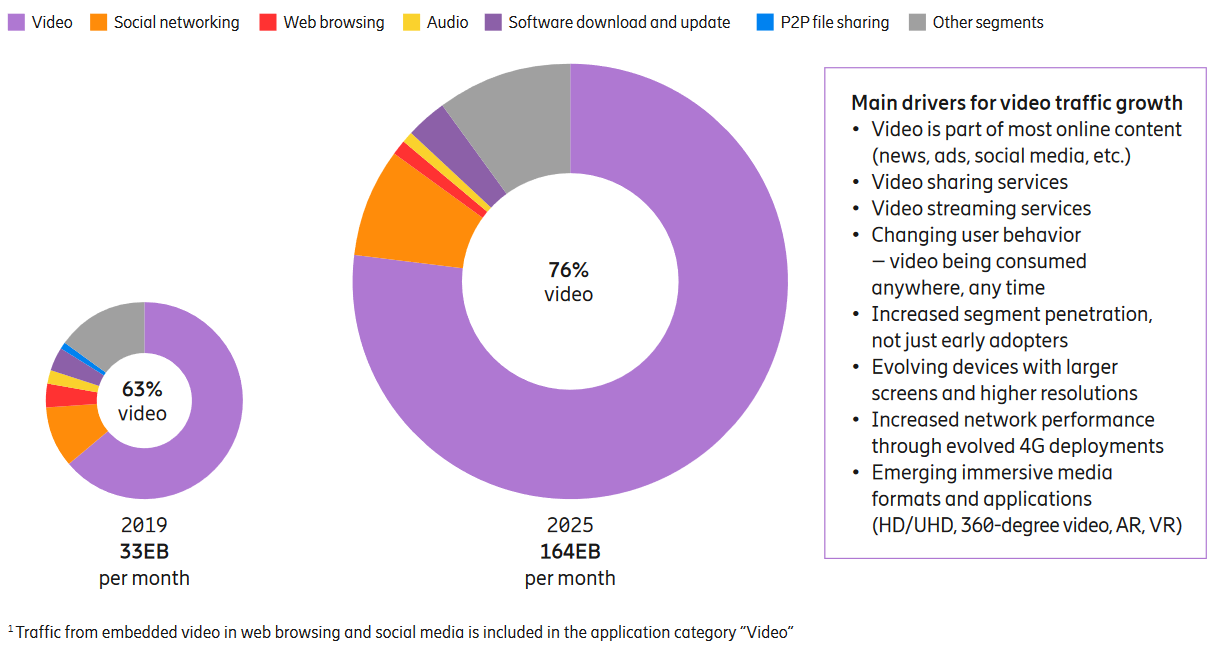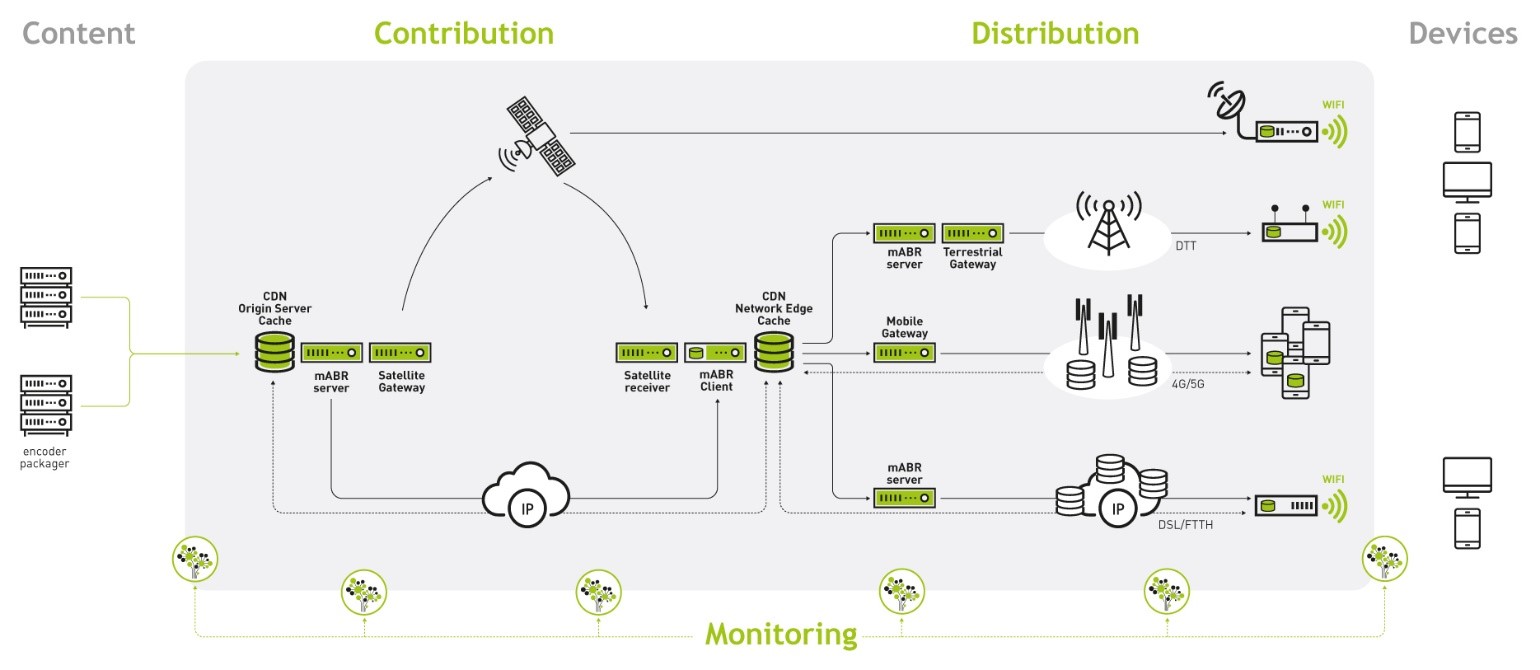
Blog
5G & Satellite Blog – Part 3 of 3: Satellite & 5G for OTT@scale
At ENENSYS Technologies, we believe that satellite is an accelerator for the deployment of 5G. It has the ability to significantly improve the reachability of 5G applications – with the major advantage of reducing investment in terrestrial infrastructure. But how exactly can satellite technology be deployed in 5G? Which architectures can be implemented? Which protocols, which functions? In this three-part blog series, we explore 5G implementation challenges & the role that Satellite Communications (SatCom) can play, how 3GPP is introducing satellite scenarios and finally, satellite & 5G for OTT@Scale.
Part 3: Satellite & 5G for OTT@scale
5G is a reality, a reality which will open doors to many new applications. A “SUPER” grid of network interconnections made up of a multitude of links – the work of the 3GPP described in Blog 2 testifies to the diversity of networks aggregated to satisfy the ambition of 5G connectivity.
However, in this 5G “world”, mobile phones will remain the main vector of data consumption.
Media and entertainment will represent an increasing share and be one of the main drivers for the network evolution. In its “5G Economics of Entertainment Report”, Ovum states that as early as 2025, 57% of the global 320 billion-us-dollar media revenue will be generated through 5G networks. This report also forecasts that 5G will accelerate content consumption, including mobile media, mobile advertising, home broadband and TV, and improve experience across a broad range of new immersive and interactive technologies.
According to the Ericsson Mobility Report from June 2020, mobile data consumption has tripled from 15EB/month in Q1 2018 to 45EB/month in Q1 2020.
Additionally, the report indicates that video consumption will represent 76% of the total data traffic in mobile networks.
Mobile Traffic by Application Category per Month (Percent)

Ericsson Mobility Report | June 2020, Page 18 https://www.ericsson.com/49da93/assets/local/mobility-report/documents/2020/june2020-ericsson-mobility-report.pdf
Therefore, video distribution in 5G networks must be closely studied and optimized – so that the networks do not become immediately saturated and so that consumers’ expectations in terms of service quality are fully met.
OTT@scale, from ENENSYS, offers a number of standardized tools to optimize OTT video distribution – one example being multicast ABR for OTT content. In contrast to the unicast ABR transport mode used today, which requires a connection/content per user (which multiplies on the network copies of the same content as many times as there are users), the multicast protocol ABR can broadcast this same content once and only once on the network and make it available to everyone. As a result, savings increase as the number of users goes up. Especially when we talk about sporting events, breaking news, concerts and all other events which people wish to see live.
And with multicast ABR, in addition to saving network capacity and reducing congestion, it also plays a role in improving latency and quality of experience for the users.
It is interesting to note that unicast vs. multicast can also be managed dynamically; it is possible to monitor the number of connections for specific content and program a threshold beyond which the broadcast switches from the unicast mode to multicast mode: Multicast Operation On Demand (MOOD).
For this service, the transport vector is very important too and can also be optimized. Indeed, even if the content is available in multicast ABR for everyone, it still has to be routed to users who may be geographically far away: it is therefore advisable to use the network component which simultaneously touches the most people. In this sense, satellite transport, with spots that can serve a country or even a continent, is a particularly efficient means of transport. A single video stream, a single transmission, and the content available simultaneously for millions of users.
Furthermore, this unique and wide distribution of multicast video streaming via satellite can be taken up by all components of the 5G network and everywhere: on land (even in the most remote places), in the air and at sea – whether in a fixed or mobile environment. It is in this context that 3GPP worked to specify the use of Satcom for backhauling of Mobile Edge.

The ENENSYS group, experts in Media Delivery and convinced that the optimization of the use of resources is at the heart of the success of future video services on digital networks, has built its OTT@scale offer in this direction. This offer is made up of the following elements:
- The MediaCast Broadband: Usually offered as software designed to acquire content from the Head-End/Origin. They stream the content using Multicast. The solution is designed to offer live sporting events and popular content delivery to millions of subscribers simultaneously. NB: Other interesting uses involve pre-positioning VoD content, in addition to delivering massive software updates to Set-Top-Boxes and consumer devices.
- The MediaCast Controller – a software application designed to configure and control the Multicast server. It obtains the content list from a Content Management System and sends the content delivery instructions to a Multicast Server. It gathers end-user consumer reports and analyzes them to decide if content should be delivered in unicast or multicast.
- SmartGate S2/S2X: a compact HTS & ACM satellite gateway that transmits OTT content over satellite.
- TeamCast Neptune: a professional multi-satellite receiver able to feed any component of the network: Telecom POP, Broadband, Wifi.
- CubeAgent: Agent in charge of the decoding of multicast streams and provide unicast access to edge cache or video player.
- Streamprobe: a powerful and versatile software solution to monitor and troubleshoot OTT delivery quality everywhere in the media transport chain.
In order to rollout this solution, ENENSYS has developed strategic partnerships with CDN providers.

With Its OTT@scale solution, ENENSYS continues to pave the way and reinforce its successful efficient media delivery strategy. Please do not hesitate to contact us if you have any questions or would like further details.
